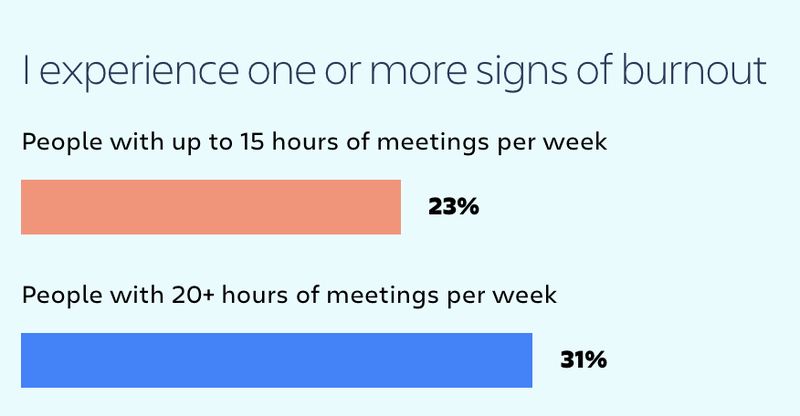This 90-minute exercise can help you ditch unnecessary meetings
As a new year begins, it’s a great time to renew your team’s working methods. And one resolution at the top of most teams’ lists is to cut meetings to make more time for deep work.
Lightening calendars is a challenge all teams grapple with—and it hits hybrid teams harder than others. According to my company’s State of Teams research, while office-only workers have roughly five hours of meetings in an average week, it’s more like eight hours for people on distributed and hybrid teams.
Read more
So why does it matter? We found that spending more time in meetings is linked with a significantly higher risk of burnout, which aligns with the body of research around Zoom fatigue.

If your team is struggling to cut down on meetings, consider running Atlassian’s Ritual Reset play. We designed this 90-minute exercise to help teams audit and re-evaluate team meetings and processes and be more intentional about synchronous vs. asynchronous work.
Here’s how you can run the play.
Step 1: Prep
For remote teams, start by creating a new collaboration document: here’s a helpful Trello template. For in-person teams, prepare a large sheet of paper or a whiteboard. If your team is distributed—meaning you have a few members who sit together, in-person, while others dial in virtually—we recommend running this play in an entirely virtual fashion by asking in-person team members to participate via Zoom.
On your document or whiteboard, create a table with 4-5 columns labeled with increasing time intervals (e.g., daily, weekly, monthly, quarterly), and create rows labeled “Full team” and “Part of team.” Then, create another table with columns labeled “Keep,” “Improve,” and “Remove.”
Step 2: Set the stage
Set the ground rules for the meeting. Tell your team:
There are no “right” or “wrong” answers.
Always assume positive intent.
Restate the purpose of the Play: to examine the team’s regular working rituals and decide what to keep, improve or remove.
Next, define “ritual” and provide a few examples. Loosely, a ritual is a repeated activity in service of the team or organization. It can be strictly work, strictly social, or a mix of both. Some examples include:
a recurring team meeting
a planning process
a team social hour
a status report for the CEO
Then, ask the team to consider what makes a successful ritual for their team, and record their answers in the shared space.
Step 3: Audit
Set a timer for 20 minutes and ask the team to audit their rituals silently. For remote teams, have them add each ritual to the shared document. For in-person teams, have them write down the rituals on sticky notes and add them to the paper or whiteboard. Group similar rituals and identify any gaps.
Step 4: Vote
Remind the group how they defined a successful ritual up front and then give them time to vote on which rituals to keep, improve, or remove. Votes can be recorded by placing different colored labels or stickers near each sticky note. Allow each person around five votes per round.
Step 5: Create an action plan
After all the votes are in, discuss and document the next steps for the top 3-5 rituals in each category. Ask questions like:
How can we ensure the rituals we should keep remain effective?
What can we try to improve the rituals we want to improve?
Who will remove the rituals we should remove from everyone’s calendars?
Make the meetings you decided to keep amazing by learning how to run a more effective meeting in this course.
Step 6: Follow up
Check in with the team 3-4 weeks later to see if the changes had an impact. Consider running this exercise annually or whenever the team’s makeup or responsibilities change.
Now it’s time to give it a try. In the next month, replace a weekly team meeting with the Ritual Reset play. I promise it will be worth the investment and set the right tone for the new year.
Mark Cruth is Atlassian’s resident Modern Work Expert. Focused on practice over theory, Mark spends his days coaching both Atlassian and customer teams on new ways of working, then sharing what he’s learned at events around the world.
More from Quartz
Sign up for Quartz's Newsletter. For the latest news, Facebook, Twitter and Instagram.
